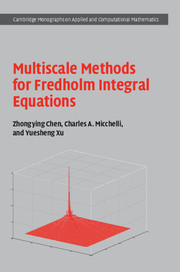Refine search
Actions for selected content:
2540 results in Computational Science
4 - Multiscale basis functions
-
- Book:
- Multiscale Methods for Fredholm Integral Equations
- Published online:
- 05 July 2015
- Print publication:
- 16 July 2015, pp 144-198
-
- Chapter
- Export citation
Index
-
- Book:
- Multiscale Methods for Fredholm Integral Equations
- Published online:
- 05 July 2015
- Print publication:
- 16 July 2015, pp 534-536
-
- Chapter
- Export citation
2 - Fredholm equations and projection theory
-
- Book:
- Multiscale Methods for Fredholm Integral Equations
- Published online:
- 05 July 2015
- Print publication:
- 16 July 2015, pp 32-79
-
- Chapter
- Export citation
9 - Fast solvers for discrete systems
-
- Book:
- Multiscale Methods for Fredholm Integral Equations
- Published online:
- 05 July 2015
- Print publication:
- 16 July 2015, pp 322-355
-
- Chapter
- Export citation
Frontmatter
-
- Book:
- Multiscale Methods for Fredholm Integral Equations
- Published online:
- 05 July 2015
- Print publication:
- 16 July 2015, pp i-iv
-
- Chapter
- Export citation
10 - Multiscale methods for nonlinear integral equations
-
- Book:
- Multiscale Methods for Fredholm Integral Equations
- Published online:
- 05 July 2015
- Print publication:
- 16 July 2015, pp 356-415
-
- Chapter
- Export citation
8 - Numerical integrations and error control
-
- Book:
- Multiscale Methods for Fredholm Integral Equations
- Published online:
- 05 July 2015
- Print publication:
- 16 July 2015, pp 300-321
-
- Chapter
- Export citation
12 - Eigen-problems of weakly singular integral operators
-
- Book:
- Multiscale Methods for Fredholm Integral Equations
- Published online:
- 05 July 2015
- Print publication:
- 16 July 2015, pp 465-487
-
- Chapter
- Export citation
Appendix - Basic results from functional analysis
-
- Book:
- Multiscale Methods for Fredholm Integral Equations
- Published online:
- 05 July 2015
- Print publication:
- 16 July 2015, pp 488-518
-
- Chapter
- Export citation
11 - Multiscale methods for ill-posed integral equations
-
- Book:
- Multiscale Methods for Fredholm Integral Equations
- Published online:
- 05 July 2015
- Print publication:
- 16 July 2015, pp 416-464
-
- Chapter
- Export citation
Preface
-
- Book:
- Multiscale Methods for Fredholm Integral Equations
- Published online:
- 05 July 2015
- Print publication:
- 16 July 2015, pp ix-x
-
- Chapter
- Export citation
Introduction
-
- Book:
- Multiscale Methods for Fredholm Integral Equations
- Published online:
- 05 July 2015
- Print publication:
- 16 July 2015, pp 1-4
-
- Chapter
- Export citation
5 - Multiscale Galerkin methods
-
- Book:
- Multiscale Methods for Fredholm Integral Equations
- Published online:
- 05 July 2015
- Print publication:
- 16 July 2015, pp 199-222
-
- Chapter
- Export citation
3 - Conventional numerical methods
-
- Book:
- Multiscale Methods for Fredholm Integral Equations
- Published online:
- 05 July 2015
- Print publication:
- 16 July 2015, pp 80-143
-
- Chapter
- Export citation
7 - Multiscale collocation methods
-
- Book:
- Multiscale Methods for Fredholm Integral Equations
- Published online:
- 05 July 2015
- Print publication:
- 16 July 2015, pp 265-299
-
- Chapter
- Export citation
Contents
-
- Book:
- Multiscale Methods for Fredholm Integral Equations
- Published online:
- 05 July 2015
- Print publication:
- 16 July 2015, pp v-viii
-
- Chapter
- Export citation
1 - A review of the Fredholm approach
-
- Book:
- Multiscale Methods for Fredholm Integral Equations
- Published online:
- 05 July 2015
- Print publication:
- 16 July 2015, pp 5-31
-
- Chapter
- Export citation
List of symbols
-
- Book:
- Multiscale Methods for Fredholm Integral Equations
- Published online:
- 05 July 2015
- Print publication:
- 16 July 2015, pp xi-xiv
-
- Chapter
- Export citation

Multiscale Methods for Fredholm Integral Equations
-
- Published online:
- 05 July 2015
- Print publication:
- 16 July 2015
Virtual geometricity is rare
- Part of
-
- Journal:
- LMS Journal of Computation and Mathematics / Volume 18 / Issue 1 / 2015
- Published online by Cambridge University Press:
- 01 July 2015, pp. 444-455
-
- Article
-
- You have access
- Export citation
